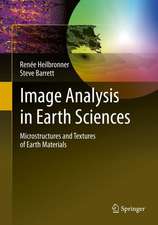Early Organic Evolution: Implications for Mineral and Energy Resources
Editat de Manfred Schidlowski, Stjepko Golubic, Michael M. Kimberley, David M. McKirdy, Philip A. Trudingeren Limba Engleză Paperback – 22 noi 2011
Preț: 606.12 lei
Preț vechi: 757.66 lei
-20% Nou
Puncte Express: 909
Preț estimativ în valută:
115.98€ • 121.42$ • 95.97£
115.98€ • 121.42$ • 95.97£
Carte tipărită la comandă
Livrare economică 02-08 aprilie
Preluare comenzi: 021 569.72.76
Specificații
ISBN-13: 9783642768866
ISBN-10: 3642768865
Pagini: 576
Ilustrații: XVIII, 555 p.
Dimensiuni: 193 x 270 x 30 mm
Ediția:Softcover reprint of the original 1st ed. 1992
Editura: Springer Berlin, Heidelberg
Colecția Springer
Locul publicării:Berlin, Heidelberg, Germany
ISBN-10: 3642768865
Pagini: 576
Ilustrații: XVIII, 555 p.
Dimensiuni: 193 x 270 x 30 mm
Ediția:Softcover reprint of the original 1st ed. 1992
Editura: Springer Berlin, Heidelberg
Colecția Springer
Locul publicării:Berlin, Heidelberg, Germany
Public țintă
ResearchCuprins
Early Organic Evolution and Mineral and Energy Resources: A Farewell Address to IGCP Project 157.- 1. Precambrian Weathering and Paleosols.- to Precambrian Weathering and Paleosols.- How to Find a Precambrian Paleosol.- Experimental Procedures to Simulate Weathering Under Atmospheres. Which May Have Characterized the Early Archean.- The Lower Proterozoic Hokkalampi Paleosol in North Karelia, Eastern Finland.- Paleosol and Ore-Forming Processes in the Elliot Lake District of Canada.- Mineralogy and Geochemistry of the Pre-1.65 Ga Paleosol Under Kombolgie Formation Sandstone of the Pine Creek Geosyncline, Northern Territory, Australia.- Carbonaceous High-Alumina Shale in the Transvaal Supergroup: Evidence of Early Proterozoic Karstic Weathering in a Marine Environment.- Significance of Precambrian Paleosols.- 2. Organic Matter in Precambrian and Early Paleozoic Sediments.- Mantle Carbon: Concentration, Mode of Occurrence, and Isotopic Composition.- Carbon Cycle and Carbon Isotope Record: Geochemical Impact of Life over 3.8 Ga of Earth History.- Precambrian Petroleum: A Decade of Changing Perceptions.- Paleontology and Biogeochemical Research: A Powerful Synergy.- Proterozoic Organic Carbon -Its Preservation and Isotopic Record.- An Assessment of the Precambrian/Cambrian Transition Events on the Basis of Carbon Isotope Records.- Stratiform and Globular Organic Matter in the Lower Proterozoic Metasediments at Elliot Lake, Ontario, Canada.- Organic Carbon Isotopic Composition of Proterozoic Sedimentary Rocks from India: Preliminary Results.- Organic Free Radicals in Precambrian and Paleozoic Rocks: Origin and Significance.- On the Atypical Petroleum-Generating Characteristics of Alginite in the Cambrian Alum Shale.- Distribution and Structure of Hydrocarbons and HeterocyclicSulfur Compounds Released from Four Kerogens of Ordovician Age by Means of Flash Pyrolysis.- Thermal Maturity of Early Paleozoic Sediments as Determined by the Optical Properties of Marine-Derived Organic Matter -A Review.- Hydrocarbon Composition of the Late Proterozoic Oils of the Siberian Platform: Implications for the Depositional Environment of Source Rocks.- Biomarkers and Other Hydrocarbons in Upper Sinian Stromatolitic Dolostones from Southwest China.- Natural Gas in Sinian Reservoirs of the Weiyuan Area, Sichuan Province: The Oldest Gas in China.- Biological Markers in Paleozoic Sedimentary Rocks and Crude Oils from the Michigan Basin: Reassessment of Sources and Thermal History of Organic Matter.- The Influence of Gloeocapsomorpha prisca on the Organic Geochemistry of Oils and Organic-Rich Rocks of Late Ordovician Age from Canada.- 3. Antiquity and Metallogenic Potential of Bacterial Sulfate Reduction.- Sulfur in the Earth’s Mantle -A Review.- Bacterial Sulfate Reduction: Current Status and Possible Origin.- Biogeochemistry of Sulfur and the Mechanisms of Sulfide-Sulfate Mineralization in Archean Oceans.- Biological and Abiological Sulfate Reduction in Two Northern Australian Proterozoic Basins.- Global Oxidation and a Supercontinent in the Proterozoic: Evidence from Stable Isotopic Trends.- Depositional and Diagenetic C — S — Fe Signatures and the Potential of Shales to Generate Metal-Rich Fluids.- Genetic Relationship Between Elementary, Organic, and Pyritic Sulfur in Sediments.- 4. Fossil Microbial Ecosystems of the “Stromatolitic” Type and Their Modern Analogs.- The History and Significance of Stromatolites.- Proterozoic and Living Cyanobacteria.- Lower Precambrian Stromatolite Associations of Karelia.- Tussocky Microstructure, a BiologicalEvent in Upper Proterozoic Stromatolites: Comparisons with Modern Freshwater Stromatolite Builders.- On the Association of Ore Deposits with Stromatolites.- Experimental Hypersaline Ponds as Model Environments for Stromatolite Formation 1. Microbenthos Composition and Biomass Accumulation.- Experimental Hypersaline Ponds as Model Environments for Stromatolite Formation 2. Isotopic Biogeochemistry.- Palynostratigraphy in Phanerozoic and Precambrian Metamorphic Rocks.- 5. General Topics.- Mineral Deposits and Metallogeny: Indicators of Earth’s Evolution.- Chemical Evolution of Sedimentary and Magmatic Rocks in the Earth’s Crust.











